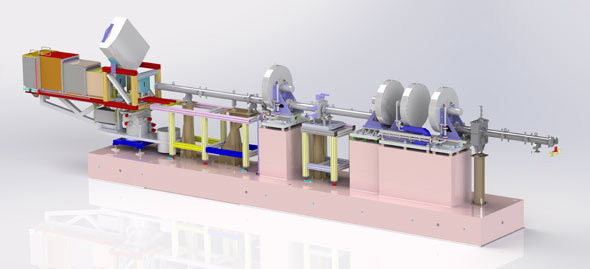A small team at ANSTO will begin the painstaking assembly of the newly acquired neutron reflectometer SPATZ, formerly known as BioRef, which has arrived safely in three shipping containers after a two-month journey from Germany.
 |
| The SPATZ team, who will assemble the instrument, stand near the three shipping containers of components. (Left to right) Anton LeBrun, David Roach, Stewart Pullen, Andrew McGregor and John Affleck |
ANSTO negotiated the transfer of the instrument from the BER-II Research Reactor at Helmholtz-Zentrum Berlin (HZB) in 2015 and renewed a MOU for scientific collaboration with the renowned German research organisation in 2016.
The instrument will be located in the Neutron Guide Hall, adjacent to the BILBY instrument at the Australian Centre for Neutron Scattering (ACNS).
Approximately 257 components were safely packed in 43 wooden crates weighing just under 30 tonnes for the sea voyage from Hamburg to Port Botany, Australia. The ship transporting the packaged crates stopped at seven ports on the 45-day voyage which covered over 11,800 nautical miles.
The project is being supervised by Instrument Scientist, Dr Anton LeBrun, and Instrument Engineer, Stewart Pullen, at ANSTO.
“The real power of this instrument is its ability to use a whole new range of sample environments that cannot currently be used on the existing reflectometer, PLATYPUS, thus expanding the ACNS capabilities in studying surfaces and interfaces,” said LeBrun.
 |
| Rendering of the SPATZ neutron reflectometer |
ANSTO staff, assisted by HZB personnel, spent four weeks in Berlin last year successfully disassembling the complex instrument, which has highly-sensitive detectors, neutron guides, choppers, and an infrared spectrometer, among other essential components.
Planning for the disassembly involved staff from ACNS, health physicians, engineers & capital programs and procurement officers and work health and safety specialists.
“Importantly, crucial consultation with a number of colleagues at HZB made this truly collaborative endeavour a success for both ANSTO and HZB,” said Pullen.
“There were 205 pages of instructions. We took close to 1000 photos while we were taking the instrument apart, and used twelve cassettes to label everything,” he added.
We expect it will take about eighteen months to re-assemble the instrument, test the components, build the neutron guide, install the 21 tonnes of lead shielding and secure the appropriate approvals from our nuclear regulator,” said LeBrun.
ANSTO is currently liaising with the German Ambassador to Australia, Dr Anna Elisabeth Prinz, to attend a ceremony in April to mark the arrival of the instrument.
SPATZ, the German word for sparrow, follows the tradition of the naming convention of other instruments at the Australian Centre for Neutron Scattering, which are named after Australian and other fauna.
It becomes the fifteenth neutron-beam instrument operated by the ACNS at ANSTO and will help meet user demand for the oversubscribed PLATYPUS neutron reflectometer.
SPATZ, which uses a high-flux cold-neutron source, can used for a wide range of applications in biomedicine, energy, and materials science. It will accommodate a range of sample environments, including cryomagnets at the ACNS.
SPATZ is expected to be available for research in late 2018 and a contingent of researchers from HZB will perform some of the first experiments on SPATZ.
Published: 14/02/2017


